Happy (U.S.) Independence Day!
While many of our friends are camping, hosting a BBQ, relaxing by the beach, or enjoying their wedding anniversaries, others are remembering the day America became a nation by honoring the men and women who have served to protect America’s freedom. One could say that visiting the William G. Mather was a way to learn about how one steamship helped preserve America’s freedom through supporting efforts during World War II.
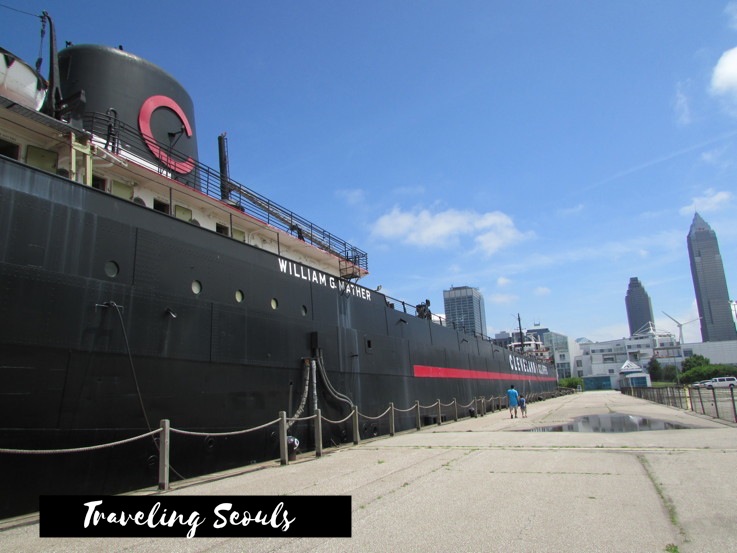
As promised, I conclude our Great Lakes Science Center visit with photos from the Steamship William G. Mather Maritime Museum. The William G. Mather, first launched in 1925, led a convoy to transport steel needed during WWII and continued its bulk freighter service for the Cleveland -Cliffs Iron Company until 1980. Donated to the Great Lakes Historical Society in 1987, the 8000+ ton bulk freighter sits along Cleveland’s North Coast Harbor on Lake Erie as a maritime museum for all to enjoy.
We’ve visited a battleship before but not a cargo ship. Walking on board the William G. Mather brought a lot of history to life for our boys. While we felt like squished sardines inside the science museum, our steamship experience was much more open, which worked out great. I don’t think we would have been able to walk through those steep steps or tight inner corridors.
Before we entered the museum ship, we got a quick geographical tutorial of the Midwest.
Geography Lesson
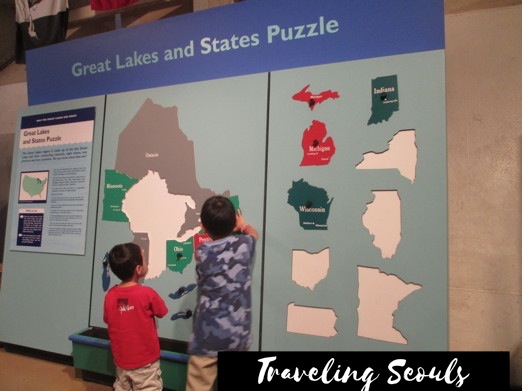
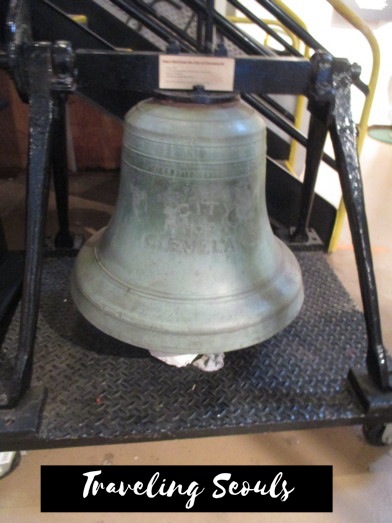
Lower Guest Lounge – Owner’s Lounge
We began our self-guided tour in nicer, more accommodating spaces – the Lower Guest Lounge, “Owner’s Lounge.” Take a look at the wood paneling, sconce lighting flanking the fireplace, and matching brown leather couch, giving it a more regal space.
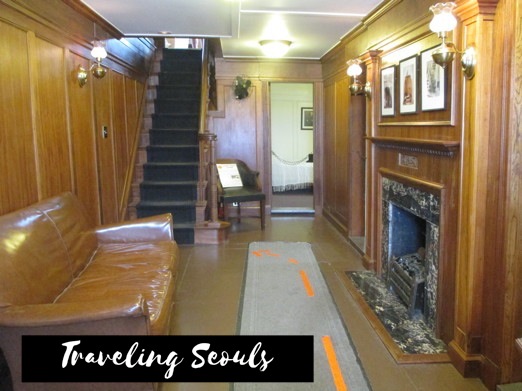
Guests aboard the steamship comprised of company executives, politicians, corporate clients, and William G. Mather, owner of the Cleveland-Cliffs Iron Company. Bedroom quarters on this side of the ship were roomy and offered radiator heating to keep you warm on those cold, windy evenings onboard.
A top hat added a personal touch to the room.
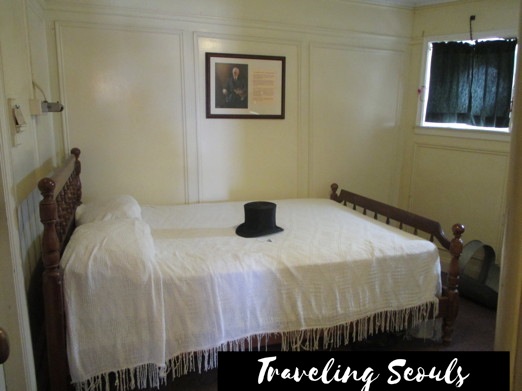
Captain’s Office
The captain’s office had lovely red leather seating at the secretary’s desk with a matching red leather love seat. The wood paneling gave it a rich luxurious look during that period.
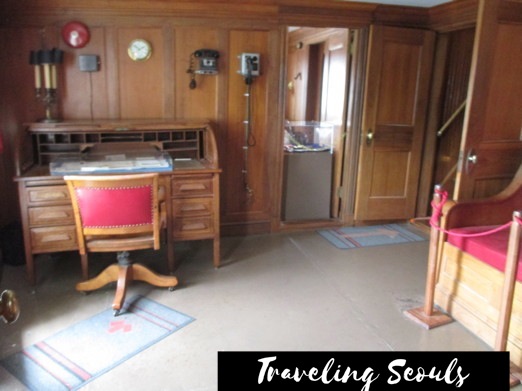
Upper Guest Lounge – Observation Lounge
The Upper Guest Lounge, “Observation” Lounge, was the main gathering space for onboard guests. According to the museum information panel, guests watched Lake Erie’s scenery, listened to music, read books, and enjoyed snacks and drinks. The Upper Guest Lounge underwent a remodel in 1967 with “modern” wall paneling.
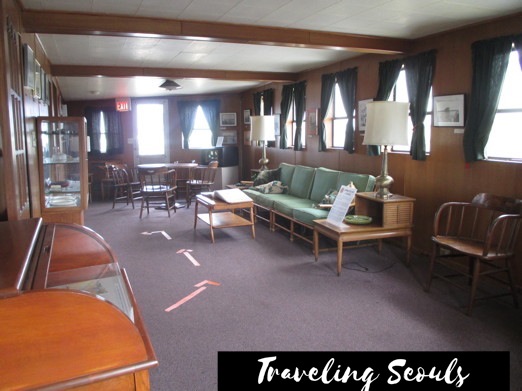
Our boys paid no attention to an old tv set. I am not even certain Piano Man would have known that was a tv since he’s grown accustomed to watching tv via DVR, pressing the pause button whenever he needed to walk away for a moment. With no DVR in those days, if guests onboard walked away or didn’t pay attention to the screen, they’d be missing out. Although I think the actual view of the lake would be more appealing than a tv view of the lake.
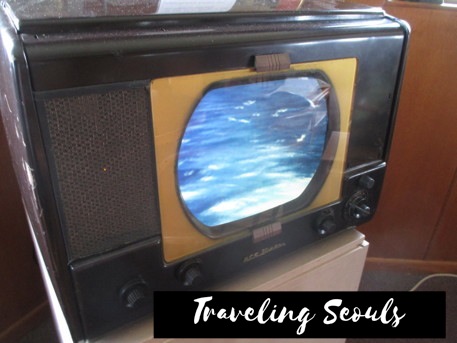
The last time we were on board a ship, we had to carry Linus up and down the stairs. His little feet couldn’t handle the steep climb. Now, he’s such a big boy, he’d much rather go and down himself. Prof and Piano Man anchored behind to ensure Linus’ safety.
The William G. Mather is a self-guided tour, but the museum staff was stationed at specific areas of the ship. In the bridge, a staffer asked the kids a question, “Who used to drive this boat?” Most would say the captain, but we learned it’s a steersman. The captain is too busy running the ship, so to be stuck behind a wheel would keep him from running the ship. After she made that comment, it made sense. When I think of those tv episodes of Star Trek: the Next Generation, watching Captain Picard on the USS Enterprise sitting in the captain’s chair, he always gave the orders, never lifting a finger to steer the ship.
In one of the crew’s quarters, I had to take a photo of this area because of the chair on the right. If you recognize the shape and style of the chair, it’s also part of the set on The Big Bang Theory, one of my all-time favorite tv shows. It’s also part of the interior look at Barnes and Noble too, but I don’t think the William G. Mather or Barnes and Noble would sell that chair at a reasonable price.
Notice how the crew member’s quarters are smaller and tighter than the guest’s quarters.
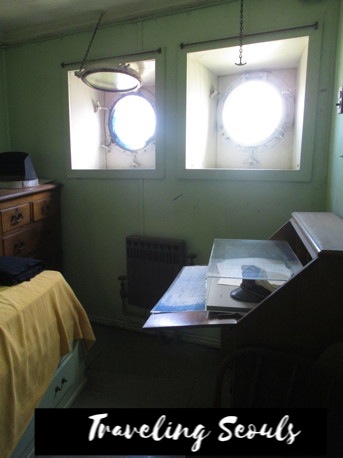
The crew’s corridors aren’t adorned with floor to ceiling wooden wall paneling but with light green painted metal. It’s very reminiscent of the walls at the Battleship Texas.
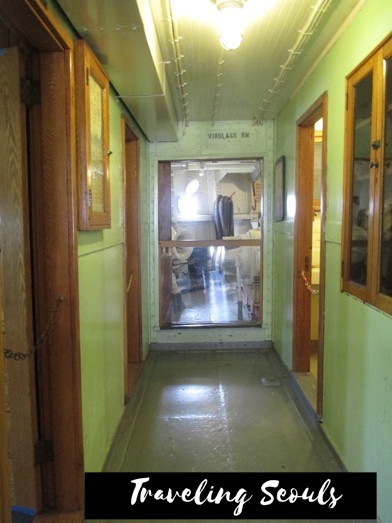
Guests’ Dining Room
Each group of people – special guests (like William G. Mather himself and other company executives) to officers and lower-level crew members – stayed in separate areas. You can tell the differences at various eating locations on The William G. Mather. Special guests used fancy china and silverware in the guest dining room.
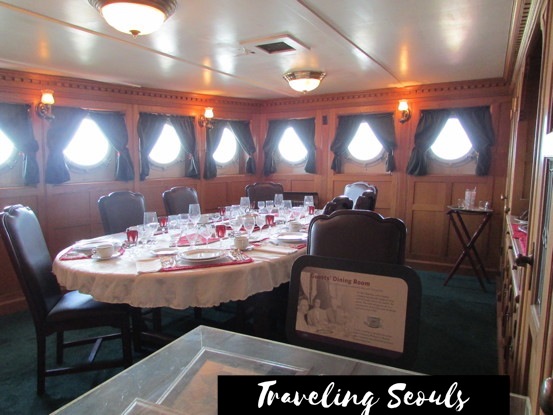
This was one of the few rooms where we could walk around in the space. Shhh…don’t tell the museum staff, but I think one of the kids might have pushed a fork out of place.
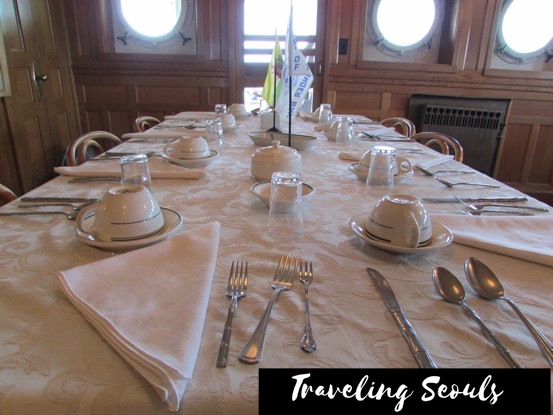
Officer’s Dining Room
Officers assigned to the steamship dined here. This meant the captain, chief engineer, mates, and assistants certified by the U.S. Coast Guard dressed in their uniforms and dined separately from other guests. I can imagine a sea-version of Downton Abbey, where the Crawley’s dressed every night for dinner. Can’t you imagine a seaside tv series of an overt drama mingling relationships between shipmates and guests?
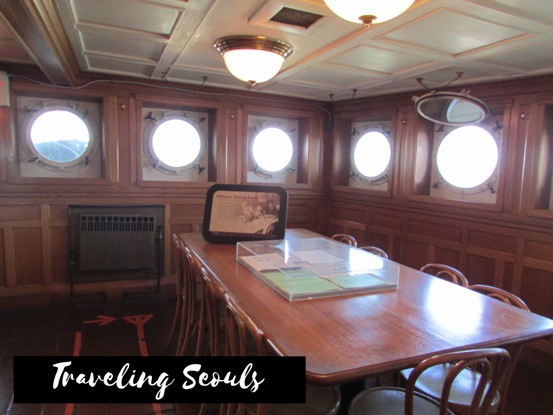
Kitchen and Galley
In the ship’s kitchen, a steward, second cook, and two porters worked in the galley. They worked long eight-hour shifts to prepare meals for everyone on board. It reminded me of a throwback 1950s kitchen with the light avocado color scheme. There even looks like a large Kitchen Aid mixer at the back of the photo below.
The galley included an electric stove, refrigerator, ice cream freezer (yum!), dishwasher, and deep fat fryer. These must be modern conveniences added later, as an ice cream freezer must have been a luxury in those days.
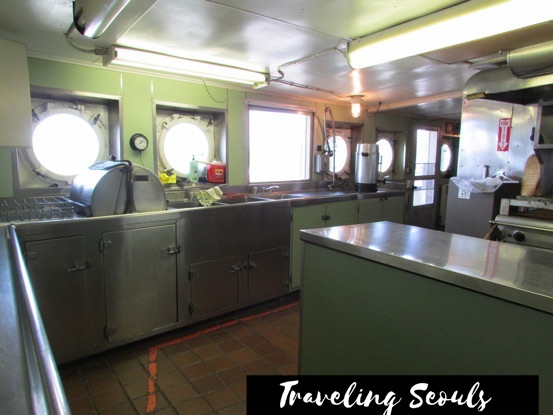
The galley crew dined here separate from the rest of the crew, which reminded me of how the service staff of Downton Abbey also ate in the lower level of the estate, away from the Crawley family. Although onboard the steamship, the galley was adjacent to the officer’s dining room.
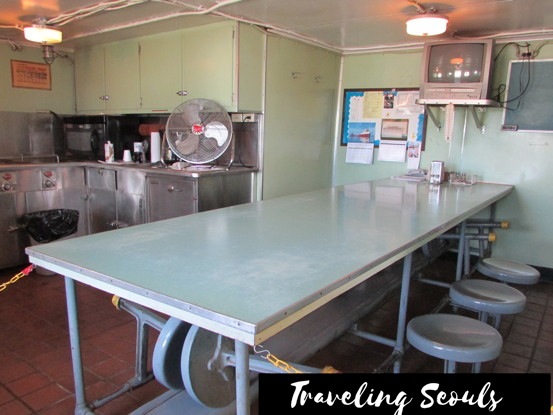
Photo Above: Don’t pay any attention to the modern tv situated above the kitchen Galley’s eating area.
Boat Deck
Auxiliary and emergency equipment, such as a life raft, life preservers, and even an emergency steering wheel, are stored at the boat deck.
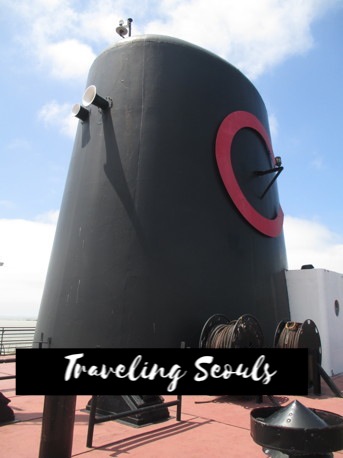
Apparently 25 people could sit on a life boat should the need arise to vacate the steamship.
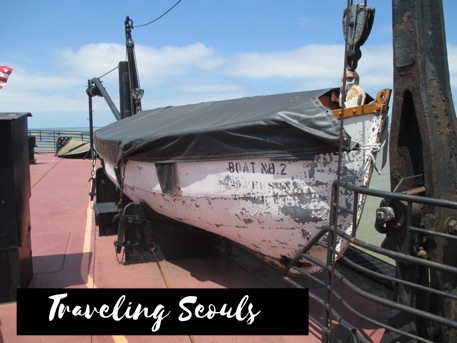
Who knew one needed an emergency steering wheel?
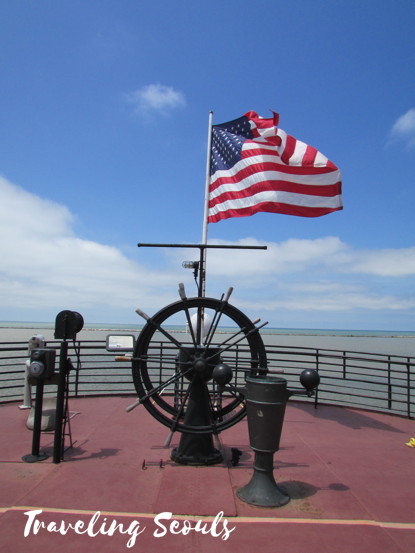
The Engine Room
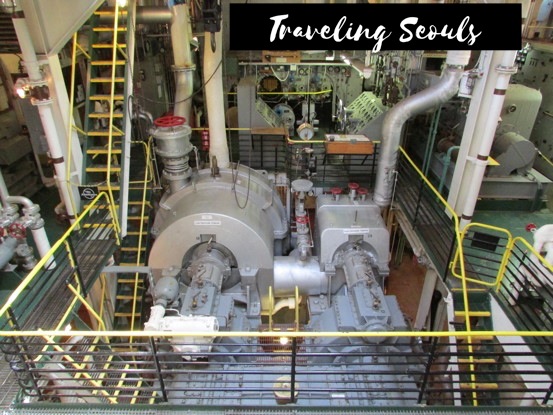
Before we left, we visited the engine room. According to the museum’s information panel, between 1925 to 1954, the William G. Mather was powered by a quadruple expansion, reciprocating steam engine. But by 1954, a steam turbine repowered the ship, improving the engine’s efficiency and increased its power capacity. Staff personnel stood watch in four-hour shifts. I imagine that one would only be able to withstand the incredible amount of heat and humidity levels for only short periods of time.

Isn’t the length of the cargo ship incredibly long? It was quite a walk from one end to the other, and the walk back was doubly long by late afternoon. We soaked up more maritime culture on this trip, and hope to find more to visit in the future.
For More Information:
Great Lakes Science Center
Wikipedia’s Steamship William G. Mather Maritime Museum
Related:
TRAVEL: Battleship Texas
TRAVEL: Great Lakes Science Center in Cleveland
TRAVEL: Cleveland Museum of Art
Pin it for Later:
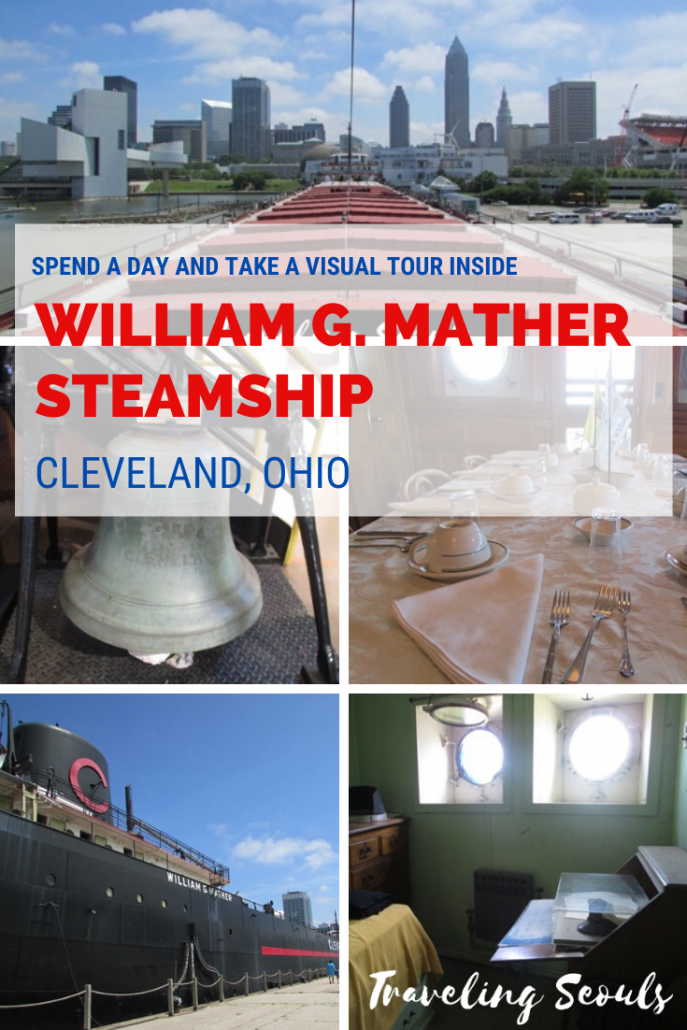



1 comment
I had the distinction of being a deckhand on the Mather in 1964 and a guest in 1965. An amazing sequence of events.